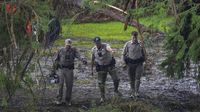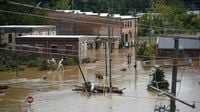Central Texas is grappling with the aftermath of one of the deadliest flash floods in recent U.S. history, as rescue teams continue their desperate search for survivors amid a mounting death toll that has reached at least 82 people, including 28 children. The catastrophic flooding, which struck during the July Fourth holiday weekend, has devastated Kerr County and surrounding areas, leaving families shattered and communities in shock.
The tragedy centers heavily on Kerr County, northwest of San Antonio, where the Guadalupe River surged dramatically—rising 26 feet in just 45 minutes before daybreak on July 4—washing away homes, vehicles, and entire cabins at summer camps. Among the hardest hit was Camp Mystic, an all-girls Christian summer camp near Hunt, Texas, where 10 girls and a counselor remain missing. The camp, which typically hosts hundreds of campers, saw many of its buildings swept away or destroyed by the floodwaters, turning a place of joy into a scene of heartbreak.
Families have been sifting through waterlogged debris and empty cabins, trying to piece together what happened as rescuers navigate challenging terrain, high waters, and even venomous snakes like water moccasins in their search efforts. As of Sunday, July 6, officials confirmed 68 deaths in Kerr County alone, including 28 children. Another 10 fatalities have been reported in surrounding counties such as Travis, Burnet, Kendall, Tom Green, and Williamson.
Texas Governor Greg Abbott has warned that the danger is far from over. With the ground fully saturated and additional rounds of heavy rainfall expected through Tuesday, the risk of life-threatening flooding remains high. Emergency alerts have been issued, urging residents in vulnerable areas to move to higher ground immediately. Abbott emphasized caution, particularly warning drivers to avoid flooded roads, underscoring the peril posed by swift-moving waters. “You may think you can drive through it, only to find out when you’re in there that it’s too late and that you’re getting swept away,” he said. “If there’s any water on the road, you gotta be safe. There’s an old saying for a reason... ‘turn around, don’t drown.’”
Search and rescue operations have been massive and multifaceted. More than 1,700 emergency responders, volunteers, and family members have joined forces, employing helicopters, boats, drones, golf carts, horses, and K-9 units to scour the flood-ravaged areas. Over 850 people have been rescued so far, many plucked from trees or stranded campsites. Yet, the grim reality is setting in as the chances of finding survivors dwindle with every passing hour. Authorities have pledged to continue searching until every missing person is accounted for, but the emotional toll is immense.
Among the stories emerging from the disaster are harrowing accounts of survival and loss. A 22-year-old woman was rescued after clinging to a tree overnight, while others were found floating on mattresses or trapped in attics. Tragically, a veteran high school teacher camping near the Guadalupe River and a woman driving to work at Walmart were among those killed. The floodwaters swept away vehicles, homes, and precious lives with terrifying speed, catching many off guard despite warnings.
The National Weather Service had issued a series of alerts before the storm, including flash flood warnings and rare flash flood emergencies, signaling imminent danger. However, questions remain about the effectiveness of local emergency notification systems and whether enough was done to prepare the community. Kerr County officials had considered installing flood warning sirens and river gauges in the past but ultimately did not implement them, citing budget concerns and local resistance to increased spending. This absence of a comprehensive flood warning system has been a point of reflection and regret as the community confronts the scale of the disaster.
Local officials, including Kerrville City Manager Dalton Rice, have promised a full review of the emergency response to improve future preparedness. “There’s going to be a full review of this, so we can make sure that we focus on future preparedness,” Rice said. Meanwhile, Texas Division of Emergency Management Chief W. Nim Kidd expressed hope and determination, saying officials are “very much fueled by the compassion that we feel for these families” and are doing everything possible to find missing loved ones.
President Donald Trump signed a major disaster declaration for Kerr County on July 6, activating federal assistance through FEMA. Although he has previously criticized FEMA and suggested phasing it out, Trump acknowledged the severity of the situation, describing the flooding as “horrible” and indicating plans to visit Central Texas on July 11. “We wanted to leave a little time,” he said, “I would have done it today, but we’d just be in their way.”
The human toll is deeply felt across communities. At Saint Michael and All Angels Episcopal Church in Dallas, over 600 people gathered for a prayer service honoring the victims, including many children from Camp Mystic. The camp’s director, Dick Eastland, was among those who perished. Attendees sang hymns and shared memories, offering solace amid the pain. Survivors and family members alike have shared stories of frantic phone calls, last-minute escapes, and the agonizing uncertainty of waiting for news.
Experts note that the Guadalupe River Basin is particularly vulnerable to flash floods, earning the nickname “Flash Flood Alley.” The region’s steep terrain and narrow river channels can cause water levels to rise rapidly with little warning, especially after prolonged droughts that leave the soil unable to absorb sudden heavy rains. This year’s flooding is among the deadliest in the United States in the past century, rivaling historic disasters such as the Mississippi River Flood of 1927 and Hurricane Katrina in 2005.
Climate scientists warn that such extreme weather events are becoming more frequent and intense due to climate change, as warmer air holds more moisture, leading to heavier downpours. When combined with aging infrastructure and limited emergency resources, the consequences can be devastating.
As the search continues and communities begin the slow process of recovery, the tragedy serves as a stark reminder of nature’s power and the critical importance of preparedness. Officials and residents alike are grappling with the question of how to better protect vulnerable areas in the future, balancing the costs of infrastructure improvements with the imperative to save lives.
For now, the people of Central Texas are united in grief, resilience, and hope—holding onto the belief that every missing person will be found and that the lessons learned from this disaster will help prevent such heartbreak in the years to come.






